#hijra
Text
In addition to my Monkey Man post from earlier, the always kind & sweet Aparna Verma (author of The Phoenix King, check it out) asked that I do a thread on Hijras, & more of the history around them, South Asia, mythology (because that's my thing), & the positive inclusion of them in Monkey Man which I brought up in my gushing review.
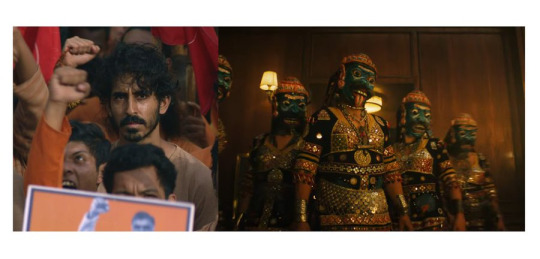
Hijra: They are the transgender, eunuch, or intersex people in India who are officially recognized as the third sex throughout most countries in the Indian subcontinent. The trans community and history in India goes back a long way as being documented and officially recognized - far back as 12th century under the Delhi Sultanate in government records, and further back in our stories in Hinduism. The word itself is a Hindi word that's been roughly translated into English as "eunuch" commonly but it's not exactly accurate.
Hijras have been considered the third sex back in our ancient stories, and by 2014 got official recognition to identify as the third gender (neither male or female) legally. Pakistan, Nepal, Bangladesh, and India have accepted: eunuch, trans, intersex people & granted them the proper identification options on passports and other government official documents.
But let's get into some of the history surrounding the Hijra community (which for the longest time has been nomadic, and a part of India's long, rich, and sometimes, sadly, troubled history of nomadic tribes/people who have suffered a lot over the ages. Hijras and intersex people are mentioned as far back as in the Kama Sutra, as well as in the early writings of Manu Smriti in the 1st century CE (Common Era), specifically said that a third sex can exist if possessing equal male and female seed.
This concept of balancing male/female energies, seed, and halves is seen in two places in South Asian mythos/culture and connected to the Hijra history.
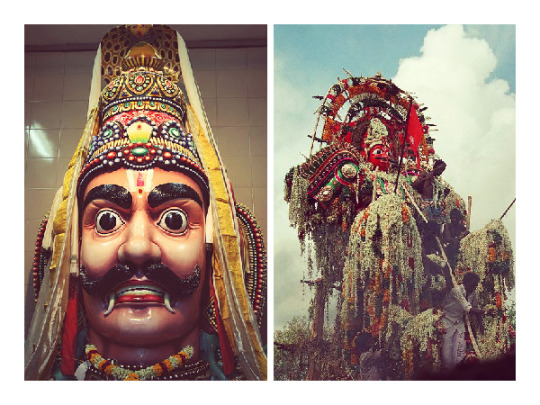
First, we have Aravan/Iravan (romanized) - who is also the patron deity of the transgender community. He is most commonly seen as a minor/village deity and is depicted in the Indian epic Mahabharata. Aravan is portrayed as having a heroic in the story and his self-sacrifice to the goddess Kali earns him a boon.

He requests to be married before his death. But because he is doomed to die so shortly after marriage, no one wants to marry him.
No one except Krishna, who adopts his female form Mohini (one of the legendary temptresses in mythology I've written about before) and marries him. It is through this union of male, and male presenting as female in the female form of Mohini that the seed of the Hijras is said to begun, and why the transgender community often worships Aravan and, another name for the community is Aravani - of/from Aravan.
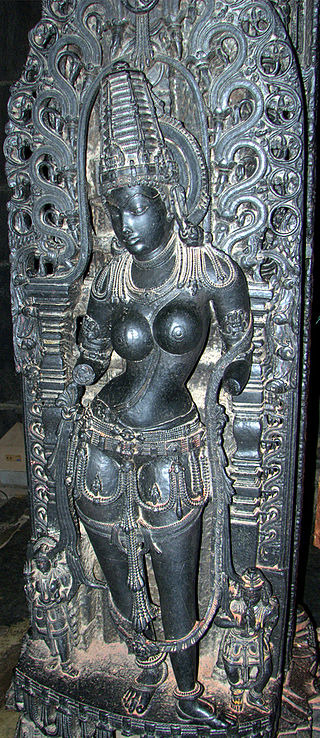
But that's not the only place where a gender non conforming divine representation can be seen. Ardhanarishvara is the half female form of lord Shiva, the destroyer god.
Shiva combines with his consort Parvarti and creates a form that represents the balancing/union between male/female energies and physically as a perfectly split down the middle half-male half-female being. This duality in nature has long been part of South Asian culture, spiritual and philosophical beliefs, and it must be noted the sexuality/gender has often been displayed as fluid in South Asian epics and the stories. It's nothing new.

Many celestial or cosmic level beings have expressed this, and defied modern western limiting beliefs on the ideas of these themes/possibilities/forms of existence.
Ardhanarishvara signifies "totality that lies beyond duality", "bi-unity of male and female in God" and "the bisexuality and therefore the non-duality" of the Supreme Being.
Back to the Hijra community.
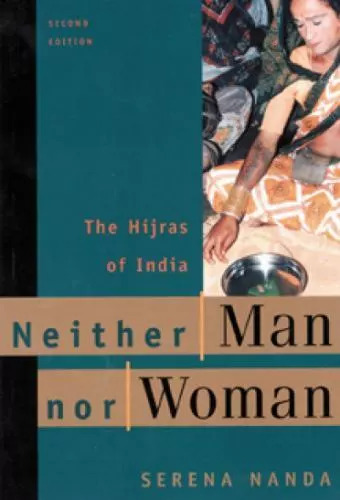
They have a complex and long history. Throughout time, and as commented on in the movie, Monkey Man, the Hijra community has faced ostracization, but also been incorporated into mainstream society there. During the time of the Dehli Sultanate and then later the Mughal Empire, Hijras actually served in the military and as military commanders in some records, they were also servants for wealthy households, manual laborers, political guardians, and it was seen as wise to put women under the protection of Hijras -- they often specifically served as the bodyguards and overseers of harems. A princess might be appointed a Hijra warrior to guard her.

But by the time of British colonialism, anti-Hijra laws began to come in place folded into laws against the many nomadic tribes of India (also shown in part in Monkey Man with Kid (portrayed by Dev Patel) and his family, who are possibly
one of those nomadic tribes that participated in early theater - sadly by caste often treated horribly and relegated to only the performing arts to make money (this is a guess based on the village play they were performing as no other details were given about his family).
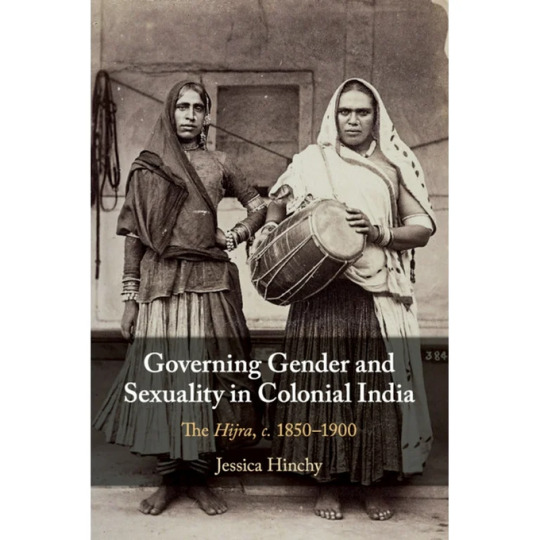
Hijras were criminalized in 1861 by the Indian Penal Code enforced by the British and were labeled specifically as "The Hijra Problem" -- leading to an anti-Hijra campaign across the subcontinent with following laws being enacted: punishing the practices of the Hijra community, and outlawing castration (something many Hijra did to themselves). Though, it should be noted many of the laws were rarely enforced by local Indian officials/officers. But, the British made a point to further the laws against them by later adding the Criminal Tribes Act in 1871, which targeted the Hijra community along with the other nomadic Indian tribes - it subjected them to registration, tracking/monitoring, stripping them of children, and their ability to sequester themselves in their nomadic lifestyle away from the British Colonial Rule.
Today, things have changed and Hijras are being seen once again in a more positive light (though not always and this is something Monkey Man balances by what's happened to the community in a few scenes, and the heroic return/scene with Dev and his warriors). All-hijra communities exist and sort of mirror the western concept of "found families" where they are safe haven/welcoming place trans folks and those identifying as intersex.
These communities also have their own secret language known as Hijra Farsi, which is loosely based on Hindi, but consists of a unique vocabulary of at least 1,000 words.
As noted above, in 2014, the trans community received more legal rights.
Specifically: In April 2014, Justice K. S. Radhakrishnan declared transgender to be the third gender in Indian law in National Legal Services Authority v. Union of India.
Hijras, Eunuchs, apart from binary gender, be treated as "third gender" for the purpose of safeguarding their rights under Part III of our Constitution and the laws made by the Parliament and the State Legislature. Transgender persons' right to decide their self-identified gender is also upheld and the Centre and State Governments are directed to grant legal recognition of their gender identity such as male, female or as third gender.
I've included some screenshots of (some, not all, and certainly not the only/definitive reads) books people can check out about SOME of the history. Not all again. This goes back ages and even our celestial beings/creatures have/do display gender non conforming ways.
There are also films that touch on Hijra history and life. But in regards to Monkey Man, which is what started this thread particularly and being asked to comment - it is a film that positively portrayed India's third sex and normalized it in its depiction. Kid the protagonist encounters a found family of Hijras at one point in the story (no spoilers for plot) and his interactions/acceptance, living with them is just normal. There's no explaining, justifying, anything to/for the audience. It simply is. And, it's a beautiful arc of the story of Kid finding himself in their care/company.
#hijra#trans representation#monkey man#dev patel#transgender#trans rights#trans rights are human rights#third sex#indian history#indian culture#colonialism#imperialism#south Asian mythos#South Asian myths#Aravan#Iravan#Mahabharata#hindu mythology#hindu gods#kali goddess#krishna#hindu mythology art#Ardhanarishvara#Shiva#Parvarti#sexuality#gender fluid#fluid sexuality#trans community#transgender rights
227 notes
·
View notes
Text

[x]
Bangladesh’s first mosque specifically for hijra Muslims has officially opened its doors, as members of the legally recognized “third gender” and transgender communities seek refuge from abuse and discrimination.
The mosque consists of a single-room building with a tin roof, paid for and built by hijras near the city of Mymensingh on government-donated land after hijra worshippers were expelled from the local community. The land already contains a graveyard and one plot, belonging to a hijra woman who was denied burial at a local mosque last year.
#things like this make me so happy bc u know what EVERYONE deserves to worship!!!!!!!!!!!!#hijra#south asia#islam#bangladesh#lgbt
180 notes
·
View notes
Text
Monkey Man gotta be one of my favorite hijra movies that features a commune of trans South Asians killing cops while their dresses twirl
#monkey man#hijra#dev patel#trans#monkey man movie#i kinda get why straight people like action movies now
95 notes
·
View notes
Photo

Hijra in 19th-century India
Today's episode is on Hijra in 19th-century India. Listen to learn about who these 19th-century Hijra were, how they structured their society, and their resistance in the face of British colonial oppression.
Learn more
Check out our website, where you can find out everything there is to know about Queer as Fact.
If you enjoy our content, consider supporting us on Patreon, checking out our merch, and following us on Twitter, Tumblr and Facebook.
[Image: A Hijra and her companions in East Bengal, 1860s]
102 notes
·
View notes
Text
Can't believe Dev Patel really said, I believe in hijra rights, hijra rights to beat up bigots with steel pipes! He was so valid for this 🙏🏻
13 notes
·
View notes
Text
12 notes
·
View notes
Text
Now feels like a good time to bring this back...


Thanks for the backup, @no-depression-for-vampires, @taliabhattwrites, @tiredguyswag & @brokenbackmountain ❤️
#anti hindutva#resources#references#queer#lgbtq+#history#hinduism#desi tag#desi tumblr#desiblr#know your history#anti colonialism#anti imperialism#transsexual#transgender#trans#nonbinary#bisexual#genderqueer#queer history#brown history#hijra#historical references
15 notes
·
View notes
Text
Trans Character of the Day

Razia Khan from Stealing Thunder/Gifting Thunder is a trans woman (Hijra) and uses she/her pronouns!
#razia khan#stealing thunder#gifting thunder#transgender#trans character#canon trans character#trans characters#trans character of the day#she/her#transfem character#trans woman#hijra
17 notes
·
View notes
Text
youtube
I haven’t watched Monkey Man yet but have read a couple reviews and am keen to see it on the big screen.
Having grown up with Indian cinema which was often Hindu nationalist AF (this is particularly the case with Hindi-language films), seeing a film embodying familiar tropes (revenge is a common motivator in Bollywood action plot lines) while also taking a firm political stance against Hindu nationalism and homophobic violence sounds 👌🏾
Also the use of Phil Collins’ “In the Air Tonight” in this trailer is perfection.
8 notes
·
View notes
Text

Mural by Aravani Art Project in New Delhi, India, celebrating Transgender community of India.
7 notes
·
View notes
Text
Mukhannath
Mukhannath/مخنثون (plural: Mukhannathun) was a gender & sexual-diverse community of Pre-Islamic & Classical Islamic Societies. Transgender & gender variant identities & practices are diverse and vary across different cultures and societies, including within Muslim communities. In Classical Arabia, these people were refer to as 1.)Effeminate men, 2.) people of ambiguous sexual characteristics and gender non-confirmity, who appeared as more feminine, 3.) who socially had roles typically played by women. There is no monolithic interpretation or understanding of gender identity or expression within Islam, as the religion encompasses a wide range of beliefs and cultural contexts. The existence of mukhannathun has been acknowledged in many historical islamic texts, and their status within Islamic society has been subject to varying interpretations.
Etymology
According to the lexicographers, the term mukhannath derived from the verb Kha-na-tha in the first form means to fold back the mouth of a waterskin for drinking. Derived term develop the basic idea of bending or folding in the direction of pliability,suppleness,languidness,tenderness& delicacy.
According to 9th century Arabic scholar, philologist Abn Ubayd mukhannathun were so called on their account of effeminacy (takassur, elsewhere usually paired with tathanni,suppleness).[citation needed]
Later lexicographers define the term mukhannath as a man who resembles or imitates as woman in the languidness of his limbs or the softness of his voice.This definition rose to prominence among Islamic scholars until medieval times, when the term became associated with passive homosexuality.
While the term "Mukhannath al-Jins" has been used to refer to individuals who do not conform to traditional gender norms associated with their assigned sex.
History
Pre-Islamic Arab Society:
Mukhannathun's gender expression & existence were much tolerated in Pre-Islamic Arab world.Mukhannathun from the city of Medina (Saudi Arabia), are frequently mentioned in the hadith literature & in the works of many Early Arabic and Islamic writers.Mukhannaths were used as domestic worker,domestic helper,hairdresser in the early days of Islam.Mukhannath were allowed to access in both male & female quarters.Al-'Ayni quotes from al-Tabarani that in the days of the Prophet Muhammad,the mukhannathun spoke languidly,dyed their hands and feet (with henna), but were not accused of immoral acts (fahisha).
In the Rashidun and Umayyad caliphates, various mukhannathun of Medina established themselves as celebrated entertainers,artists.One particularly prominent mukhannath, Abū ʿAbd al-Munʿim ʿĪsā ibn ʿAbd Allāh al-Dhāʾib, who had the Arabic name Ṭuwais ("Little Peacock"), was born in Medina on the day Prophet Muhammad died (8 June 632).
Ṭuwais is described as the first mukhannath person to perform "perfect singing" characterized by definitive rhythmic patterns in Medina.He was also known for his sharp wit and his skill with the tambourine (which had previously been associated only with female musicians).No sources describe his sexuality as immoral or imply that he was attracted to men.But it is reported that he was married with a woman.
While Ṭuwais is typically described as the leading mukhannath musician of Medina during his lifetime.Another Mukhannath who was known by the name al-Dalāl ("the Coquettish") is mentioned as one of Ṭuwais's favorite pupils.He is portrayed as a witty but sometimes crude man who "loved women," but did not have sex with them.Unlike Ṭuwais, some tales involving al-Dalāl do suggest that he was attracted to men.Furthermore Ṭuwais and other mukhannathun musicians formed an intermediary stage in the social class most associated with musical performance: women in pre-Islamic Arabia, mukhannathun in the Rashidun and early Umayyad caliphates, and mainly non-mukhannath men in later time periods.
In the early Umayyad period, Mukhannathun enjoyed an exceptional visibility and prestige in Medina & Mecca.Religious persecution of mukhannathun first started at the reigns of Caliph Marwan I. The governor of Mecca serving under al-Walīd I “issued a proclamation against the mukhannathun”, in addition to other entertainers. Two mukhannath musicians named Ibn Surayj and al-Gharīḍ are specifically referred to as being impacted by this proclamation. Mukhannath al-Gharīḍ fled to Yemen and never came back to Saudi Arabia.The most severe instance of persecution is typically dated to the time of al-Walīd I's brother and successor Sulaymān ibn ʿAbd al-Malik, (7th caliph of the Umayyad caliphate).According to several variants of this story, the caliph Sulayman ordered the full castration of the mukhannathun of Medina.Some versions of the tale say that all of them were forcefully undergo the castration procedure. Consequently, mukhannath or queer folks of Medina & Mecca begin to fade from historical sources, and the next generation of singers and musicians had few mukhannathun in their ranks.
Abbasid Period
During the Abbasid caliphate, the word itself was used as a descriptor for men who are entertainer and submissive or effeminate gay.Mukhannath were employed as dancers, musicians, comedian & guards of Abbasid harems.In later eras Mukhannath term has been mostly associated with effeminate homosexuality.
Safavid Period
Safavid Dynasty (1501–1736) was a Twelver Shia dynasty of Iran.Mukhannathun also appeared in Safavid Era.
Acceptance of transgender and gender non-conforming individuals within Islam can be highly influenced by cultural, social, political & regional factors. Different Muslim majority countries & communities may have differing attitudes towards gender identity and expression, ranging from acceptance to stigmatization.
Hadith Literature
Almost all references of ahadith literature justifies animosity toward queer people & have been quoted out of context; Islamic clerics,scholars wrongly condemn trans folks, despite so many major Islamic scholars having argued that the Hadith actually refer to cross-dressers (who want to deceitfully gain access to women’s spaces).
According to Sahih Bukhari 4324, Narated by Umm Salama narrated that ''Prophet (ﷺ) came to me while there was an mukhannath (Hit) sitting with me, and I heard him (i.e. the effeminate man) saying to `Abdullah bin Abi Umaiya, "O `Abdullah! See if Allah should make you conquer Ta'if tomorrow,then take the daughter of Ghailan (in marriage) as (she is so beautiful and fat that) she shows four folds of flesh when facing you, and eight when she turns her back." The Prophet (ﷺ) then said, "These (effeminate men) should never enter upon you (O women!)."
Al-Tabari (1978) took it as an example that the Prophet did not forbid a particular mukhanath, Hit, from entering the women’s quarters until he heard Hit giving a description of the women’s bodies in great detail.Hit was later prohibited from the house because ze had breached the trust of the Prophet, but not because of her gender identity or expression.According to Dr. Scott Siraj Kugle the mukhannath hadiths were so grossly taken out of context by many muslim conservatives,that what appeared to be a prophetic wisdom of protecting and sanctifying the privacy of women’s spaces; devolved into a punitive condemnation of gender & sexual diversity.
Its also known that Prophet Muhammad protect a Mukhannath (or trans woman) from death sentence.
According to a Sunan Abu Dawud 4910,narrated by Abu Hurayrah that,
''A mukhannath who had dyed his hands and feet with henna was brought to the Prophet (ﷺ).He asked: What is the matter with this man? He was told: "Messenger of Allah! He imitates the look of women." So he issued an order regarding him & he was banished to an-Naqi. The people said: Messenger of Allah! Should we not kill him? He said: I have been prohibited from killing people who pray.
According to Abu Usamah said: Naqi' is a region near Medina and not a Baqi ''.
According to Progressive Muslim scholar Mahdia Lynn, ''One group interprets this hadith as a transgressor banished: this person being sent away clearly teaches us that gender diverse people are not welcome in the Prophet’s community. According to this interpretation, living out the prophetic example today means that excluding gender and sexual diversity from Islam is right and good.
Another group looks at this story and sees a life saved: it’s clear there was a group of men ready to murder this person and so the Prophet saved their life by sending them away (to an-Naqi, a location between Mecca and Medina, which is interpreted to mean “within the bounds of Islam”). Living out prophetic example means not only accepting gender & sexual diversity as a valid part of the ummah, but being called upon to protect LGBTQI+ Muslims.''
Opinions
Within Islamic history and scholarship, there have been discussions and debates surrounding gender identities and expressions that transcends the gender binary.In the pre-modern period, muslim societies were aware of several gender non-confirmities: this can be seen through figures such as the khaasi (eunuch), the hijra (non-binary,trans), the mukhannath (trans-feminine),the mutarajjilat (trans male), the mamsuh (agender),the bissu (non-binary, polygender),the sida-sida (bigender) and the khuntha (intersex). Some Islamic scholars have explored the concept of "mukhannathun," which actually refers to individuals assigned male at birth but who exhibit feminine characteristics or behaviors.
Several scholars such as Mehrdad Alipour (2017) & Everett K. Rowson (1991) point to references in the Hadith to the existence of mukhannath: a man who carries femininity in his movements,in his appearance, and in the softness of his voice.Western scholars Aisya Aymanee M. Zaharin & Maria Pallotta-Chiarolli see the term mukhannath as referring to men who are behave like women,but do not want to undergo sex reassignment surgery,in contrast to transgender or intersex people.
Mukhannath term may use as an umbrella term for gender & sexual diverse.While sometimes Mukhannath classified as transgender people,the Mukhannathun as a group do not neatly fit into the western categories of gender or sexuality.There was too much variety from one Mukhannath to the next to establish a specific label for their gender or sexual identity, & the meaning of the term has changed over time.The Arabic term for a trans woman is Mukhannith, as they want to change their sex, while mukhannaths presumably don't.
In Popular Culture
Books
The Effeminates of Early Medina - Everett K. Rowson
Homosexuality,Transidentity and Islam -Ludovic Ahmad Zahed
Before homosexuality in Arab-Islamic World - Khaled El-Rouayheb
Sexual Ethics and Islam - Kecia Ali
Living Out Islam:Voices of Gay, Lesbian & Transgender Muslims - Scott Siraj Kugle
Homosexuality in Islam:Critical reflection on gay, lesbian & transgender muslims - Scott Siraj Kugle
Que(e)ring Religion:A Critical Anthology - Gary David Comstock, Susan E. Henking
Islam and Homosexuality - Samar Habib [volume 1], [volume 2]
Sexual and Gender Diversity in Muslim World - Vanja Hamzić
Islamic Homosexualities - Stephen O. Murray, Will Roscoe
Islamicate Sexualities:Translations across Temporal Geographies of Desire - Afsaneh Najmabadi,Kathryn Babayan
Queens, Eunuchs and Concubines in Islamic history - Taef El-Azhari
The Diesel (الديزل) by Thani al-Suwaidi
The Delight of Hearts - Ahmad Al-Tifashi
Governing Thirdness: State, Society and Non-Binary Identities - Muhammad Azfar Nisar
Films & TV
Allah Loves Equality - Wajahat Abbas Kazmi
Be Like Others - Tanaz Eshaghian
#gay muslim#transsexual muslim#transmuslim#queer history#queer islam#Hijra#Mukhannath#Mukhannith#khanith#transgender#non binary#genderqueer#gender ambiguity
36 notes
·
View notes
Text
Random questions Google can't help me with:
(even if you don't know, reblog could help a LOT in getting to "the person who knows". So thank you 😊)
1. Islam - How likely it is that Jason use the Hijra (hijaric?) Calander during his time with the LoA🤔
2. Geo-history: spoken languages in Western Asia around 1,300-1,500? Doesn't have to be spesific by years, just sort of. I try to get the possible location, language, religious and calander for some things.
3. what language do the All-caste speak?
Current thoughts:
LoA!
Probably somewhere in the Zagros Mountains? Maybe in the Iranian part. They do speak Arabic, but also Urdo, parasian and pashto. The main Dialect is Arabic, bc it's Ras Al-Ghul og language and that's how he taught his students.
(Also - mybe related to religious? Muslim probably (DoB ~1,300). And iirc being able to read the Qur'an properly has important meaning? I AM NOT MUSLIM PLZ CORRECT ME).
It has a lot of hiding places, wondering tribes, and places to grow food. Going to missions can hide as wonderers.
All-caste!
In the Himalayas, but "Himalayas" is f* HUGE.
WHERE??? Bhutan? China? India? Nepal? Pakistan?
#batman#jason todd#history#geography#geo-history#maps#historic maps#linguistics#all caste#all blades#help#questions#arab#asia#hijra#calander#LoA#league of assassins#league of shadows#ra's al ghul#pakistan#india#himalayas
32 notes
·
View notes
Text


Hijra flag !! (with and without lotus)
These are for any south asian who identifies as Hijra, just credit me if you use my flag!!
#mogai#mogai post#mogai coining#actually mogai#mogai flag#mogai term#critinclus#flag coining#hijra#south asian#south asian exclusive
9 notes
·
View notes
Text
DECOLONIAL QUEER HISTORY SERIES
Hijras are the third gender of South Asia. Some hijras might identify as women, but others would also identify as neither male or female, or as “in-between”.
Hijras have been part of South Asia’s culture for thousands of years. They were celebrated in sacred Hindu texts, including the Mahabharata, and they enjoyed influential positions in the courts of the Mughal empire.
The current climate of discrimination and ostracism they suffer is a direct consequence of colonialism. When Britain colonized India a lot of laws were passed criminalizing sexual diversity and non-binary genders expressions, including Hijras, who created their own communities and their own secret code language for protection.
Since 2014 legislations to recognized a separate third gender category on official documents have been passed in India, Nepal, Pakistan, and Bangladesh.
Photographer Dayanita Singh wrote about her friendship with an Indian hijra where she reported, “When I once asked her if she would like to go to Singapore for a sex change operation, she told me, ‘You really do not understand. I am the third sex, not a man trying to be a woman. It is your society’s problem that you only recognise two sexes.'”
sources: theguardian.com/pbs.org
DISCLAIMER: Terms under the LGBTQ+ umbrella are Western terms.
A lot of these communities might not or would not have felt identified with such terms. Due to colonialism, imperialism, and aggressive religious expansions a lot of these communities' history was destroyed, however they managed to survive to this day one way or another, and they are part of the global queer community and history.

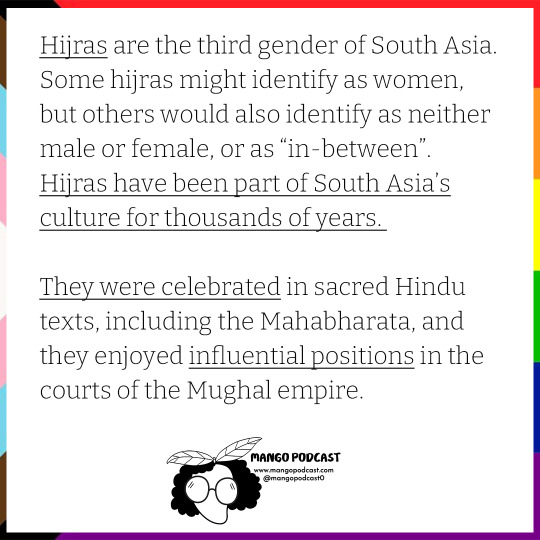
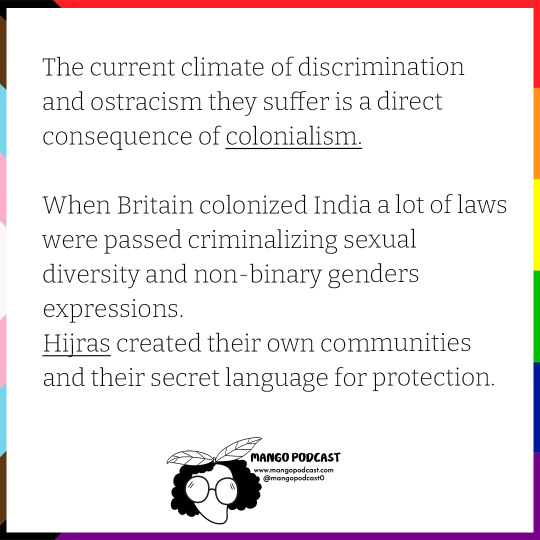

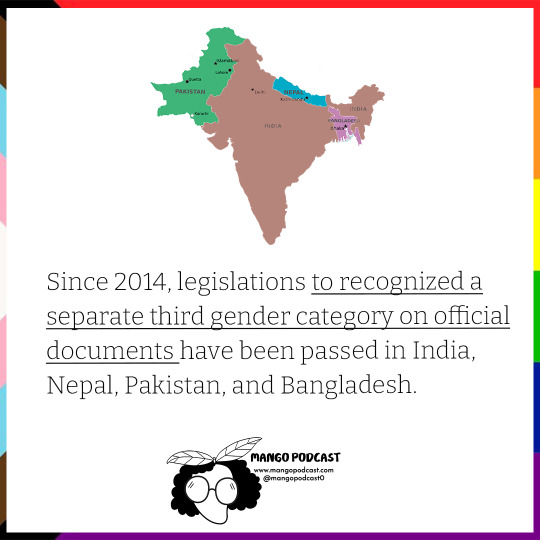

#decolonialqueerhistory#hijras#hijra#southasia#india#nepal#pakistan#bangladesh#decolonize#decolonise#lgbtq+#black history#history#africa#europe#leftism#nonbinary#decolonisation#united kingdom
9 notes
·
View notes
Text
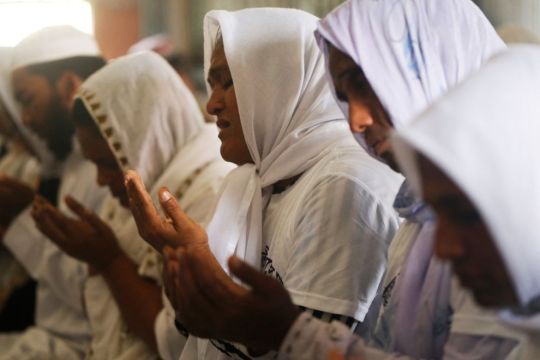
2024: Members of the hijra community offer Friday prayers during the Muslim holy fasting month of Ramadan at the Dakshin Char Kalibari mosque in Mymensingh, Bangladesh. [Rehman Asad/AFP]
14 notes
·
View notes
Text
Discrimination Faced by the Hijra Community
Many in Western cultures hear of people identifying as something other than male or female and think it’s a new fad. Something that’s just started recently and will decline in popularity some day soon. However, in Hindu cultures, a third gender has been recognized for over 2,000 years. They are called “hijras” and are described as a third, completely different gender with spiritual ties. Though…
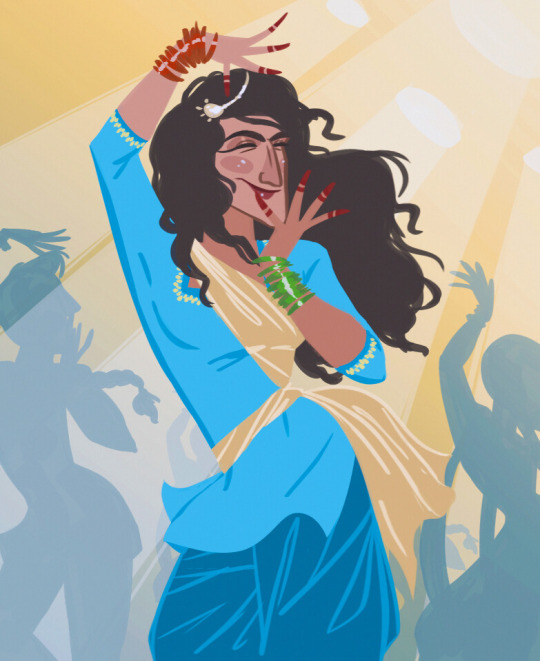
View On WordPress
#advocation#education#gender#hijra#hindu#hinduism#homophobia#intersex#learning to advocate#lgbtq#non-binary#nonbinary#third#third gender#transgender
2 notes
·
View notes